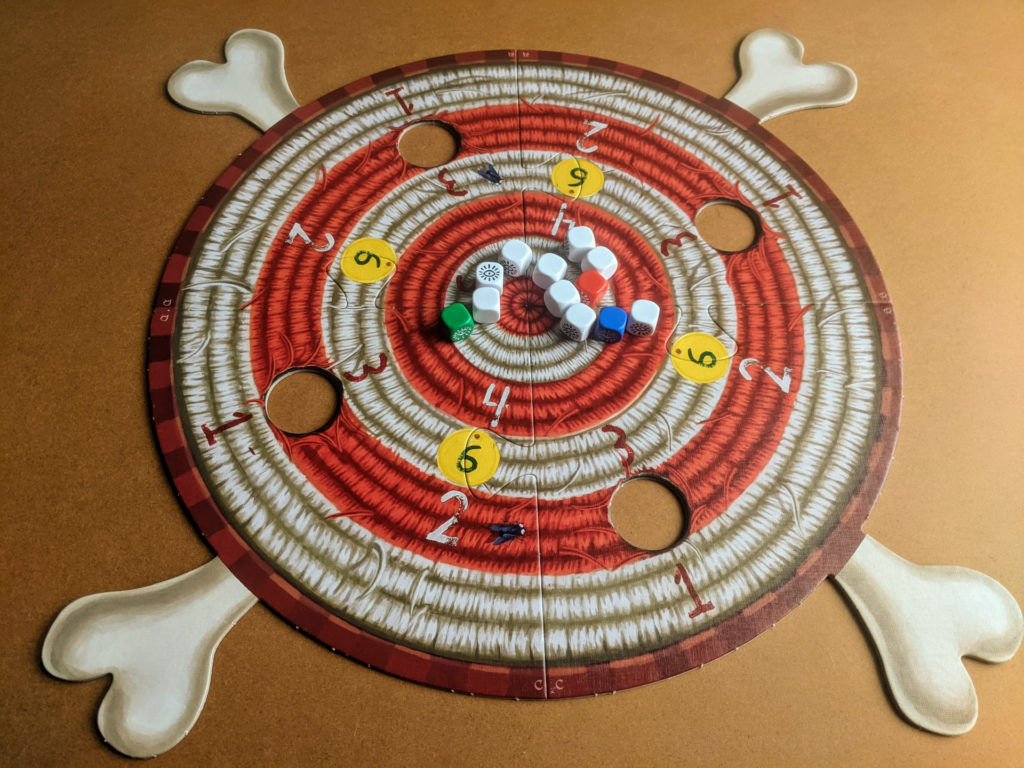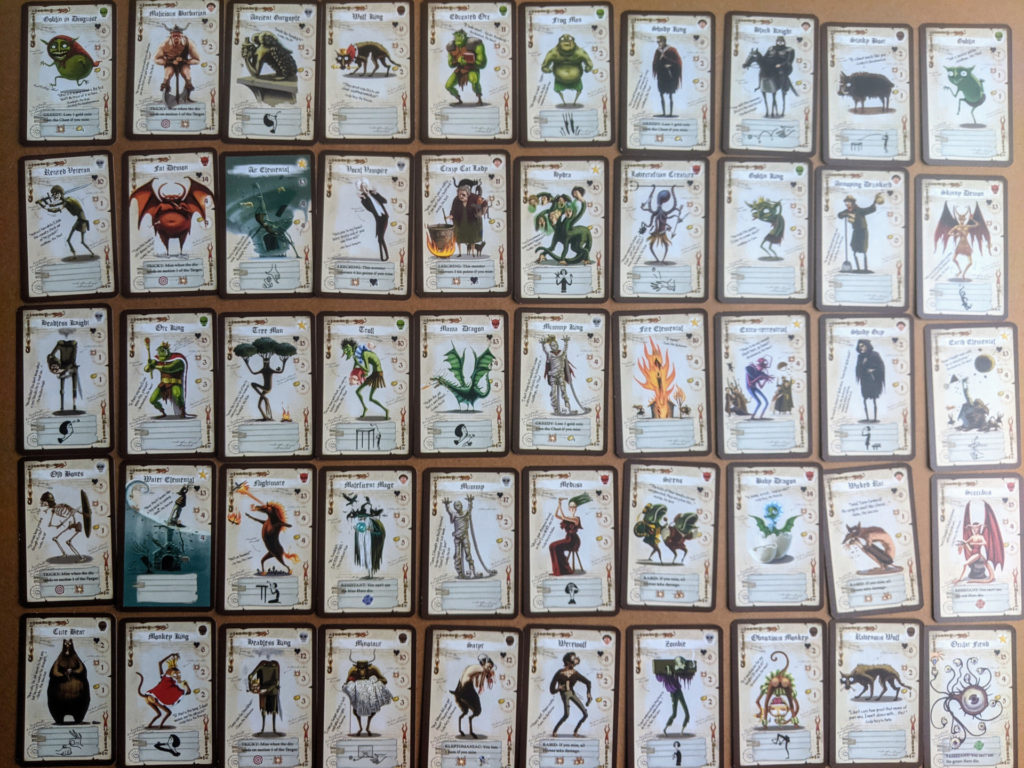“I am telling you, I can throw the die off my elbow while not looking.”
“Okay, let’s see it.”
“Right, this one is a test throw.”
*blows the die off their elbow, barely hits the board*
“Again.”
*blows the die off their elbow, misses*
“Again.”
*blows the die off their elbow, hits the board in the middle.*
*tries five more times, succeeds more than fails.*
“Okay, I’m ready, I can do this.”
*tense silence, everybody holds their breath*
*blows the die off their elbow*
*…and misses by a meter.*
Dungeon Fighter is technically a dungeon crawler, but in reality it is a fun, almost party-category dexterity game.
According to the story, all the proper heroes are gone, and only “toothless charlatans and wheezing, uneducated ruffians remain” in the kingdom. The king of the land gets angry at these ne’er-do-wells, so he seizes them and throws them into the most dangerous dungeons of the realms, so those who survive can prove their heroism, and those who don’t at least serve as nutrition for the monsters.
The players get to take up the mantle of one of these good-for-nothing scoundrels and try to get through one of the realms’ most notorious dungeons.
The story of the game is much darker than what I would have anticipated, but you can probably tell that the point of the game is to be a dungeon crawler parody. Don’t worry, the game does play as a parody, not as a dark existential comedy.

The core concept is the following: there is a central target board with different areas having different numbered values. You throw your dice on the target board, letting it bounce once on the table before reaching the board, and the area your die lands on determines your damage. A simple enough concept with lots of potential.
As you progress through the dungeon you have to fight increasingly more powerful monsters damaging them with you impeccable dice throws, gain loot from their corpses, buy new gear, descend to the next level, etc, until you reach the final boss. Once you have defeated the big bad, you win and can do silly victory poses. I am not making this up, this is part of the rule book.
Each character has three colour-coded special abilities which can be triggered by landing a die of the corresponding colour with its bulls-eye side up. There are three coloured dice in total, so before fighting rounds usually an interesting discussion takes place about trying to figure how to distribute the dice.
Everything revolves around dice throwing in this game, so you might be wondering, what does a weapon look like in this framework? I’m glad you asked. You see, you can do basic damage with the vanilla one-bounce throw, but real badass heroes can take on special weapons that increase their damage, the only wrinkle is that the weapon requires you to modify your throwing technique. For example, you might have to throw your die from under the table, do a jump, or use someone else’s hand.

The dungeon rooms and monsters can have similar requirements for dice throws. A room might demand you to throw the die while facing away from the table, or the monster can only be damaged if the die was thrown with your weak hand. Now, a vigilant reader might point out that once you start combining random throwing requirements you might end up with impossible combinations, which is entirely true. Which is why planning your route through the dungeon is important and try to avoid rooms that have ridiculous rules. Of course, you can get unlucky with a specific monster-room combination, in which case the whole party can take a specific amount of damage depending on the monster’s level to draw a new enemy.
The Good
Dungeon Fighter is a very fun game, we have had it for at least seven years, and we never ever had a bad game. It is our go-to game when we need to entertain non-gamer people. It is compatible with alcohol, with medium-large groups, younger and older people, basically with everyone under any circumstances.
The entertainment is also constant and never gets boring. You enjoy your turn because, well, throwing dice in contorted positions is fun, and you are also entertained by other player’s turns because you get to watch people act like fools.
The character and monster cards are all funny, full of easter eggs and little call-backs. It is worth reading through them.
There is also a card holding tower for your monster cards, which is surprisingly satisfying to use and looks cool on your table.

Surprisingly, navigating the map requires weirdly complex decisions in this game, should we take the longer route, risking encountering impossible to defeat monsters for some extra loot, or should we rush? It seems like a simple enough question on the surface, but after getting through one or two levels of the dungeon the risk of losing health and getting injured is real.
Another great part of the game is buying gear. A shopping round usually ends up in heated debates with people trying to prove that they are perfectly capable of landing the die on the target board by using only their noses. And then sceptics would point out that that is really difficult to do. And you end up with a show-off where someone has to prove in front of the groups their nose-throwing abilities by landing the die three times on the board. Good times.
The end of the game culminates in a boss fight that has somewhat different mechanics compared to the previous fights, so it feels different and more grande, giving you that warm and fuzzy end-of-game boss feeling.
The Bad
You can tell that we like the game a lot, but it has limitations. I wouldn’t recommend playing Dungeon Fighter too often, since each game plays pretty similarly. We usually don’t replay it with the same exact group of people, so I am not sure how fast it would get boring.
The game can also sometimes drag a bit, and you need to carefully calibrate the difficulty for your group. This is supposed to be a fun party game, nobody wants to die while fighting the first snotty goblin.

The Co-Op
Interestingly, there aren’t many co-op mechanics in the game. But it still plays well as a co-op game.
First of all, you are invested in everyone’s turn. The game has good dramatic tension built into it. You congratulate each other for spectacular throws, you try not to laugh too hard about spectacular failures, and you feel the tension when the group starts to run out of available dice when fighting a particularly difficult monster. All this gives you a pretty good co-op experience.
On top of this great shared excitement you also have group discussions on which way to go, and who should get which die. Then you have weapons like the sword of friendship, when you need to use your neighbour’s wrist to flick the die, which requires high levels of co-operation.
The Recommendation
We recommend Dungeon Fighter, it is easy, fun, and everyone can enjoy it, regardless of their background. It is a decent party game, and its fantasy theme is light enough so that most people can relate to it.
Info
| Release Year | 2011 |
| Genre | Dexterity |
| Difficulty | Medium |
| Number of Players | 1 to 6 |
| Length | 1-2 hours |
Rating
| Overall | Good |
| Story | Mediocre |
| Co-Operation | Good |